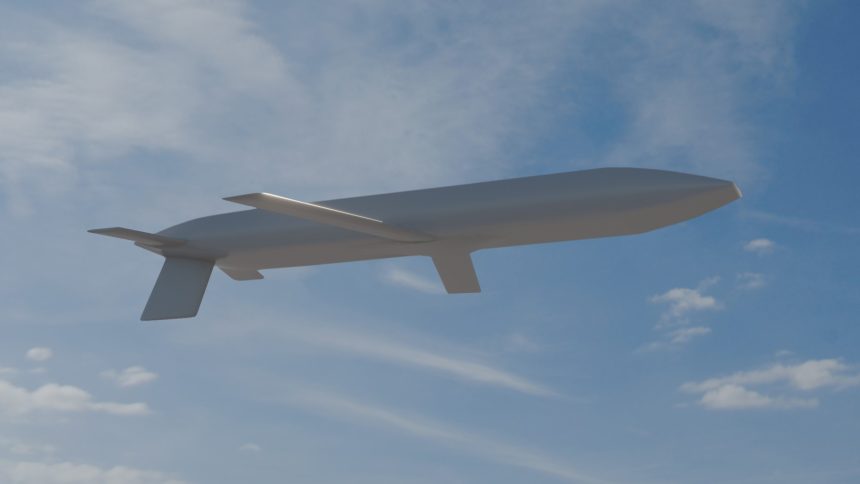The U.S. Air Force has released for the first time a rendering of the new AGM-181A Long-Range Standoff (LRSO) which is set to replace the current AGM-86B ALCM.
The U.S. Air Force has released for the first time, on Jun. 9, 2025, a rendering of the new AGM-181A Long-Range Standoff (LRSO), the service’s next-gen stealth nuclear cruise missile that is set to replace the older AGM-86B Air Launched Cruise Missile (ALCM). The weapon is currently on track to be employed by both the B-21 Raider and the B-52 Stratofortress in the near future.
The LRSO is a priority for the Air Force as the U.S. is working to modernize its nuclear triad, and has been defined as a critical capability for the B-21 Raider. The new stealth bomber is set to be equipped with three nuclear weapons: the AGM-181 LRSO cruise missile and the B61-12 and B61-13 bombs, with the latter used exclusively by the Raider.
As the weapon is being tested in secret, last year the Air Force’s then Service Acquisition Executive Andrew Hunter told the Senate Committee on Armed Services that the program is on track. “It is tracking well, the program is definitely on track to meet its timeline and deliver to the warfighter any day and we’re also doing well on cost for that program as well,” said Hunter.
The rendering
The rendering published on June 9 is the first to publicly show the new weapon. However, given the secrecy of the program, it should not be given for granted that the rendering is fully accurate, as some features might have been altered for security reasons.
For once, the air inlet can’t be seen in the rendering, and this could be due to the inlet being on the top side or completely removed from the image as it is one of the weapon’s critical features. While not much is known about the LRSO’s capabilities, the weapon is expected to be propelled to subsonic speeds by an air-breathing engine.
The rendering shows that the AGM-181 has a trapezoidal shape, with a wedge-like profile both at the nose and tail. Similarly to the weapon it will replace, the LRSO is equipped with folding wings, as well as a vertical tail on the bottom side and slightly canted horizonal tail planes.
The AGM-181 LRSO
The AGM-181 Long Range Standoff (LRSO) Cruise Missile is a long range survivable standoff weapon capable of delivering lethal nuclear effects on strategic targets, which will replace the currently fielded AGM-86 Air Launched Cruise Missile (ALCM). The LRSO will be integrated on both the B-52 Stratofortress and B-21 Raider bomber aircraft.
The LRSO weapon system will be capable of penetrating and surviving advanced Integrated Air Defense Systems (IADS) from significant standoff ranges to prosecute strategic targets in support of the Air Force’s global attack capability and strategic deterrence core function.
In 2020, the Air Force selected Raytheon as the prime contractor for the program and, a year later, LRSO entered Engineering, Manufacturing, and Development (EMD). In 2022, it was revealed that LRSO conducted nine successful major flight tests demonstrating its ability to safely separate from the B-52H aircraft, as well as weapon flight surface deployment, engine operations, flight control actuations and controlled flight.
Initially, the Air Force and Congress have also been discussing potential acquisition of conventionally armed variants of the missile. However, it was later decide to not pursue a conventional warhead version of the LRSO, with the Air Force now looking to the AGM-158B JASSM-ER (Joint Air-to-Surface Standoff Missile-Extended Range) and the AGM-158D JASSM-XR (JASSM-Extreme Range) to fill the requirement for a conventional air-launched cruise missile.
The Air Force mentioned in its fact sheets that a total of 1,715 of AGM-86B missiles were produced, although in 2007 the service announced the decision to reduce the inventory to 528 missiles. The weapons are set to be retired by 2030, replaced by approximatively 1,020 AGM-181s, according to The War Zone, quoting a Pentagon acquisition report.
In late 2022, the program’s total cost was estimated in about $16 billion, with the most recent estimates mentioning a cost per unit of about $14 million, instead of the expected $10 million, as reported in 2024 by Air and Space Forces Magazine. A low-rate initial production decision is expected in fiscal year 2027.









